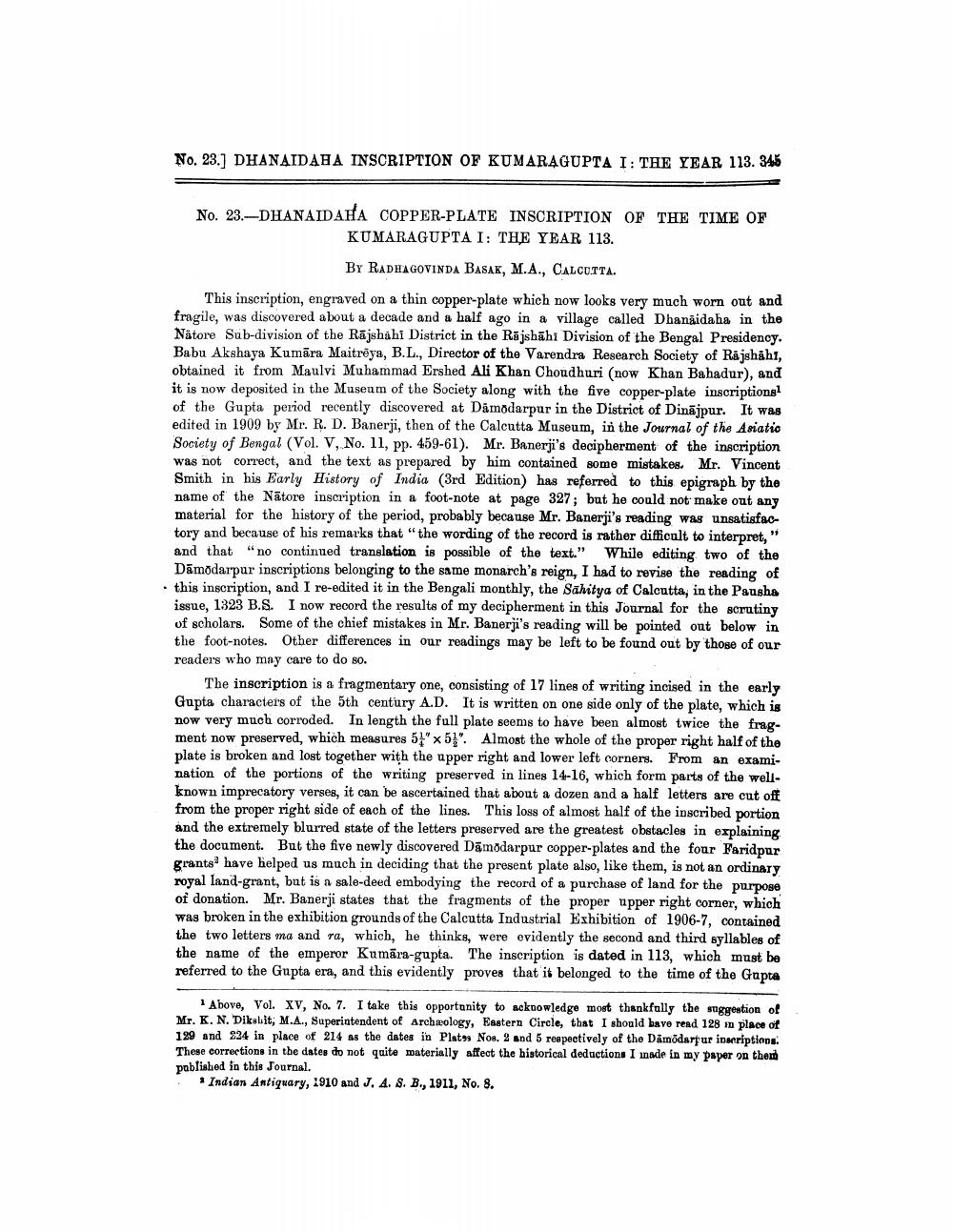________________
No. 23.] DHANAIDAHA INSCRIPTION OF KUMARAGUPTA I: THE YEAR 113. 345
No. 23.-DHANAIDAHA COPPER-PLATE INSCRIPTION OF THE TIME OF
KUMARAGUPTA I: THE YEAR 113.
BY RADHAGOVINDA BASAK, M.A., CALCUTTA. This inscription, engraved on a thin copper-plate which now looks very much worn out and fragile, was discovered about a decade and a half ago in a village called Dhanäidaha in the Nätore Sub-division of the Rajshahi District in the Rājshāhi Division of the Bengal Presidency. Babu Akshaya Kumāra Maitreya, B.L., Director of the Varendra Research Society of Rājshāhi, obtained it from Maulvi Muhammad Ershed Ali Khan Choudhuri (now Khan Bahadur), and it is now deposited in the Museum of the Society along with the five copper-plate inscriptions of the Gupta period recently discovered at Damodarpur in the District of Dinäjpur. It was edited in 1909 by Mr. R. D. Banerji, then of the Calcutta Museum, in the Journal of the Asiatic Society of Bengal (Vol. V, No. 11, pp. 459-61). Mr. Banerji's decipherment of the inscription was not correct, and the text as prepared by him contained some mistakes. Mr. Vincent Smith in his Early History of India (3rd Edition) has referred to this epigraph by the name of the Nātore inscription in a foot-note at page 327; but he could not make out any material for the history of the period, probably because Mr. Banerji's reading was unsatisfactory and because of his remarks that “the wording of the record is rather difficult to interpret," and that "no continued translation is possible of the text." While editing two of the
Damodarpur inscriptions belonging to the same monarch's reign, I had to revise the reading of · this inscription, and I re-edited it in the Bengali monthly, the Sahitya of Calcutta, in the Pausha
issue, 1323 B.S. I now record the results of my decipherment in this Journal for the scrutiny of scholars. Some of the chief mistakes in Mr. Banerji's reading will be pointed out below in the foot-notes. Other differences in our readings may be left to be found out by those of our readers who may care to do so.
The inscription is a fragmentary one, consisting of 17 lines of writing incised in the early Gupta characters of the 5th century A.D. It is written on one side only of the plate, which is now very much corroded. In length the full plate seems to have been almost twice the fragment now preserved, which measures 5%" x 51". Almost the whole of the proper right half of the plate is broken and lost together with the upper right and lower left corners. From an examination of the portions of the writing preserved in lines 14-16, which form parts of the wellknown imprecatory verses, it can be ascertained that about a dozen and a half letters are cut off from the proper right side of each of the lines. This loss of almost half of the inscribed portion and the extremely blurred state of the letters preserved are the greatest obstacles in explaining the document. But the five newly discovered Damodarpur copper-plates and the four Faridpur grants' have helped us much in deciding that the present plate also, like them, is not an ordinary royal land-grant, but is a sale-deed embodying the record of a purchase of land for the purpose of donation. Mr. Banerji states that the fragments of the proper upper right corner, which was broken in the exhibition grounds of the Calcutta Industrial Exhibition of 1906-7, contained the two letters ma and ra, which, he thinks, were evidently the second and third syllables of the name of the emperor Kumāra-gupta. The inscription is dated in 113, which must be referred to the Gupta era, and this evidently proves that it belonged to the time of the Gupta
Above, Vol. XV, No. 7. I take this opportunity to acknowledge most thankfully the suggestion of Mr. K. N. Dikslit, M.A., Superintendent of Archæology, Eastern Circle, that I should bave read 128 in place of 129 and 224 in place of 214 as the dates in Plats Nos. 2 and 5 respectively of the Damodarpur inariptions These corrections in the dates do not quite materially affect the historical deductions I made in my paper on them published in this Journal.
Indian Antiquary, 1910 and J. A. S. B., 1911, No. 8.




